review by Sharon Peoples
Travelling the Silk Road: Ancient Pathway to the Modern World is a buy-in exhibition from the American Museum of Natural History, New York. The exhibition, at the National Museum of Australia in Canberra from 31 March until 29 July 2012, sets out to explore the cultural, social, technological and economic impact of the network of trading routes and exchanges that are termed under the umbrella, the Silk Road. Four diverse cultural centres, Xi’an, Turfan, Samarkand and Baghdad, are used as anchors to illustrate and support these themes. The Silk Road was a conduit system that extended overland from the East Asia to the Mediterranean Sea, although scholars now extend the route to include Sub-Sahara, describing the network as an Afro-Eurasian world route.

©American Museum of Natural History, Division of Anthropology
At the entrance of the exhibition the visitor is greeted with two large camels, loaded up with packs and heading out of the exhibition space. Large digitally printed textiles full of text, maps and imagery introduce and locate the in-bound audience. The next set of doors slide open into a darkened space, with intricate light patterns and shadows on the floor, setting the scene for an ‘exotic’ encounter with the first city of the exhibition, Xi’an, as it was in 618–907 AD. The use of quotes, prints, audiovisuals and objects are employed to explain information on the production, history and mythologies of silk in China.

photograph by R Mickens ©American Museum of Natural History, Division of Anthropology
The exhibition moves on to a display case of musical instruments. Recordings of sounds produced by these intriguing instruments can be heard when each of the six buttons are pressed. Small ceramic sculptures illustrate how the objects were used.
Weaving back across the floorspace, information on the geographic movement of religions and spiritual practices throughout Asia and the Middle East are displayed before the visitor arrives in the night market of Turfan, under a grapevine-covered marketplace with a soundtrack ostensibly to add atmosphere. The variety of goods traded and exchanged across the route is exhibited through ‘market stalls’ displaying wares such as fibres, textiles and dyes; medicinal ingredients; pigments and aromatics; food and wine; and luxury goods. Across from the market is a wall of texts and photographs of Turfan, as an oasis city. Here information is used to show water irrigation technologies that still support remote agrarian societies.

photograph by R Mickens
©American Museum of Natural History, Division of Anthropology
The audience is then led on to a space to sit and watch short computer-animations that seemed to have been taken from old Chinese prints. These children’s stories are used to indicate that cultures no doubt exchanged more than tradable goods. The very familiar childhood tale of the goose that laid the golden egg illustrates how ideas spread without common language and between literate and non-literate societies proliferated along the route.
Walking on to Samarkand there is a display of papermaking, which originated in China. A variety of paper pulps such as hemp, flax and mulberry are exhibited, accompanied by a show of calligraphic and writing systems. The audience then moves on to an exhibit of the lavish lifestyle of those who lived in a Sogdian house through the use of text, a silkscreen image and some metal artefacts.
An interactive table recaps what had previously been shown throughout the exhibition before the visitor heads into ‘Baghdad’. This city is described as both a centre and an active diffuser of scholarly activities, knowledge and technologies. Objects related to astronomy, ceramic and glassmaking illustrate the vigorous systems of Afro-Eurasian exchanges.
The final sections of the exhibition explore sea travel as both an adjunct to the Silk Route and a speedier form of transportation of goods from the extremities of Asia across to the Middle East, and beyond to Sub-Sahara and Europe. The last display examines contemporary global connections and communications through language, music, mapping, cities and trade , using a press button interaction.
The logistics and mechanisms of a travelling exhibition seem to override and compromise many exhibition considerations. There are a substantial number of facsimiles, images and an overwhelming number of text panels printed onto textiles. The anchored diaphanous silk that gently moves as people make their way around the exhibition contributes to a sense of theatricality as well as an unfortunate feeling of inauthenticity. A former museum/gallery director was heard to quip that the exhibition ‘was like the set of Kismet’. Although there is a great deal of didactic information, the theatrical style dominates.
On entry, with so much printed text, there is a sense that the exhibition is aimed at adults, but on seeing the word ‘passport’ on a panel, it seemed that perhaps the exhibition was intended for a wider audience, with this hint of a children’s activity. Subsequently, at each ‘city’, there again was a ‘passport’ panel. However, these panels are, curiously, very high up and out of children’s sight lines. Looking around, I saw no indication if or when anything was available for young people (although I later found out that ‘passports’ for children were available from the ticketing desk – perhaps they were out of stock the day I was there). Indeed, the low text panels and bench-like displays around the silk-making displays suggest that this is an exhibition for children. However, once past the video animations of stories and the interactive table before ‘Baghdad’, there is not much in it for children. Understandably there is generally a time limit of attention for children unless they are absolutely captivated. Perhaps the designers recognised, as John Falk has shown in Identity and the Museum Visitor Experience, that the first 15 minutes of a visit is the peak of content focus.

photograph by D Finnin
©American Museum of Natural History, Division of Anthropology
The low number and variety of objects in the exhibition gave the feeling that Canberra audiences were only seeing half of the original exhibition. The proliferation of facsimiles and photographic imagery was not fulfilling. The authentic object and its aura can teach us much. When reviewer, Edward Rothstein, described the New York opening of Travelling the Silk Road for the New York Times, he referred to 90 rare artefacts. Either he was relying on a puffed up press release, didn’t closely read the labels or the Canberra version was a smaller show.
Indeed the show has been on the road since 2009 and would have been in development a few years before that. Much has happened in that short time in ideas about the role of museums and their exhibitions, and as a result, audience expectations have changed. Exhibitions have becomes signposts for further information. Not only have the technologies available for museum exhibitions developed rapidly, but also notions such as the visitor-centred approach and the participatory museum have become part of the museum experience, particularly the National Museum of Australia experience.
There are so many issues that could have been examined through the notion of the Silk Road, such as a route for genes, diasporas, disease or trans-ecological exchanges. These are all within the realm of the American Museum of Natural History. The waxing and waning of the route seems to be attributed to the eclipsing of the transport technologies of sea travel rather than the rise and fall of the political powers of those who travelled and controlled parts of the route. This not only includes those of the Roman Empire, or the Mongol empire, or the rulers and traders of the Indian sub-continent, but also the pastoralists and the nomads who, in their exchanges, made the constantly shifting network of pathways dynamic.
My disappointments in the exhibition were in its conventional account of the Silk Road, the lack of learning opportunities and the dearth of any contextual material describing parallel trading routes, such as the trading of ochre and pearl shell by Indigenous Australians or the Macassan trading networks in northern Australia.
Sharon Peoples lectures in the Museums and Collections Program at the Australian National University.
| Exhibition: | Travelling the Silk Road: Ancient Pathways to the Modern World |
| Institution: | American Museum of Natural History, New York; in collaboration with Azienda Speciale Palaexpo, Roma, Italy; Codice Idee per la cultura srl, Torina, Italy; the Museum at Marina Bay Sands, Singapore; the National Museum of Australia, Canberra, Australia; Art Exhibitions Australia; the National Museum of Natural Science, Taichung, Taiwan; United Daily News, Taipei, Taiwan |
| Curatorial team: | Mark Norell (American Museum of Natural History), William Honeychurch (Yale University), Denise Leidy (Metropolitan Museum of Art) |
| Exhibition design: |
Department of Exhibition, American Museum of Natural History, under the direction of David Harvey |
| Catalogue: | Mark Norell, Denise Patry Leidy and Laura Ross, Traveling the Silk Road: Ancient Pathway to the Modern World, American Museum of Natural History, New York, 2011 |
| Website: | www.nma.gov.au/exhibitions/travelling_the_silk_road/home www.amnh.org/exhibitions/past-exhibitions/traveling-the-silk-road/about-the-exhibition |
| Venue/dates: | National Museum of Australia, Canberra 31 March – 29 July 2012 |
